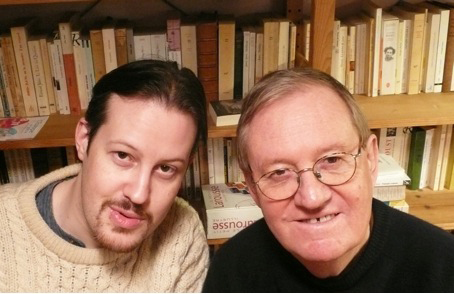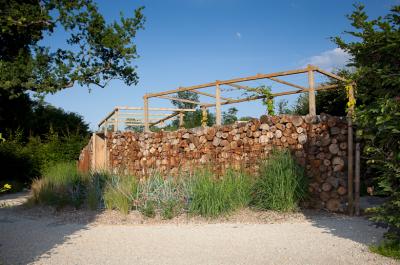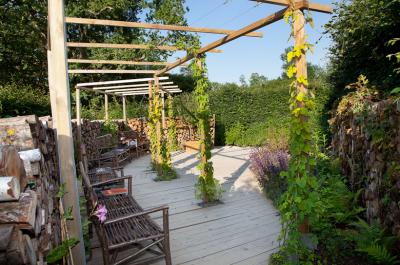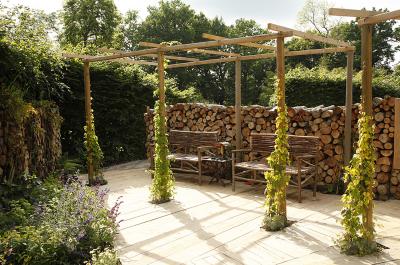07. Le jardin de la terre gaste
Green card given to Jean-Pierre and Tangi Le Dantec

“He pushed the cart and both he and the boy carried knapsacks. {…} Are you okay? he said. The boy nodded. Then they set out along the blacktop in the gunmetal light, shuffling through the ash, each the other’s world entire.” Cormac McCarthy, The Road.
“This place was so beautiful, so pleasant and delightful, that eloquence itself would find itself too poor in terms, figures and colours of rhetoric, if it wanted to take pleasure in describing it […]: since it was the real retreat of blissful games and pleasures.” Francesco Colonna, The Dream of Poliphilo.
Since time immemorial, in every civilisation, the garden’s primary function has been to offer its occupants well-being for the soul and body within a protected space. The garden enclosure is a place of retreat, hidden away from a hostile, exhausting, unhealthy or devastated world, which offers human beings the wherewithal to regain their strength and health thanks to its vegetable produce, while at the same time providing them with the calm and beauty appropriate for meditation and a restful soul.
Now new threats have appeared. They cannot be compared with what came before, as they call into question the very existence of the planet. Thus, global warming is already turning large areas of arable land into deserts in the most fragile and deprived areas of the globe. This means that an extremely urgent mission has been assigned to the garden today: to be, symbolically and materially, a place of resistance that opposes the progress of this new waste land.
This is what our garden will strive to represent in an allegorical way. On one side, a strip of arid land; on the other, on a slightly lower level, a “hortus conclusus” of our time, protected from this advancing desert by a “protective wall” of short wooden logs that lets the light filter through in its central section; finally, a pathway, leading from the waste land to the garden, will allow visitors to move round “in a loop”.
Our garden will therefore have as its aim bringing together, in a single place, not only two possible illustrations of a world to come, but also two gardening tensions presented as contradictory by the Scottish artist, Ian Hamilton Finlay, in one of his aphorisms: “Certain gardens are described as retreats when they really are attacks.”
DESIGNERS

Jean-Pierre Le Dantec is an architect, engineer and writer. He is an emeritus professor of the National Higher Institutes for Architecture and taught at the National Higher Institute for Nature and Landscape in Blois, managed the National Higher Institute for Architecture of Paris – La Villette, where he also managed the “Architecture, environments, landscapes” laboratory. He is an expert in the art history of gardens and landscape architecture and has published numerous works on the subject, including Le Roman des jardins de France [The Story of Gardens in France]. Their history (in collaboration with his sister Denise, Plon then Bartillat and The MIT Press); Jardins et Paysages [Gardens and Landscapes]. A critical anthology (Larousse, then éd. de La Villette); Le Sauvage et le régulier [The Wild and the Ordered]. Art of Gardens and Landscape Gardening in France in the 20th century (Le Moniteur). But he is also a novelist (Graal Romance [Grail Romance], Albin-Michel; Ile Grande, La Table ronde; Les Corps subtils [Subtle Bodies], Seuil; Etourdissements [Spells of Giddiness], Seuil).
His son, Tangi Le Dantec, is a state qualified architect. Right from his childhood, he became acquainted with botany during walks with Professor André-Georges Haudricourt, the French linguist, botanist, geographer and ethnologist, Director of Research at the CNRS [National Centre for Scientific Research] (1911-1996). His project for his diploma, entitled “La Maison de la troisième nature” [The Third Nature House] combined an ecological building dedicated to the art of gardens and an experimental garden. He is now involved in a project group at the National Higher Institute for Architecture of Paris – La Villette focused on the relationships between architecture, landscape and environmental quality.


